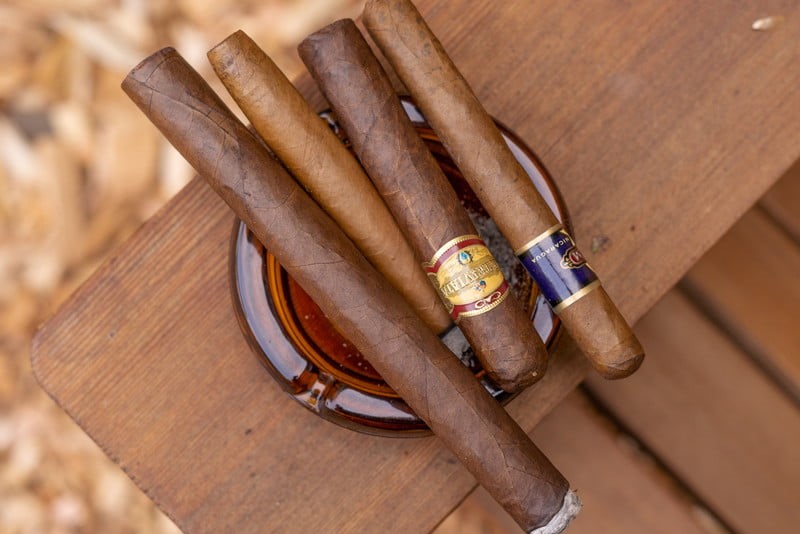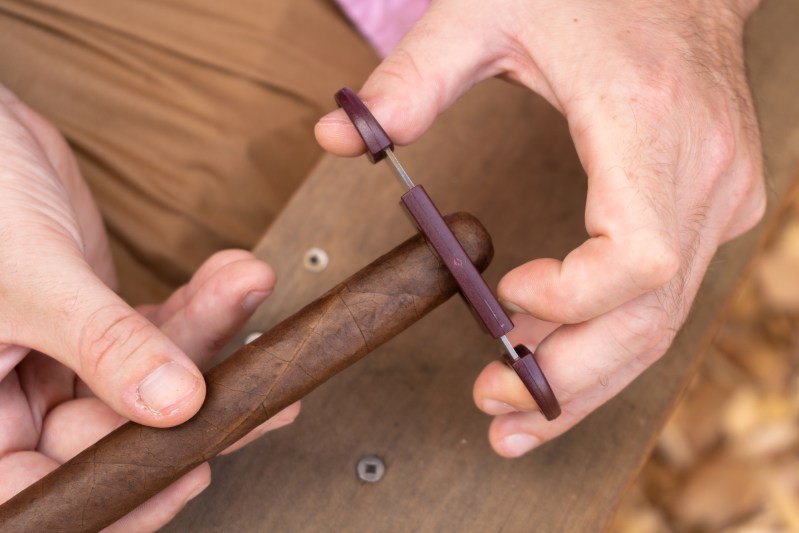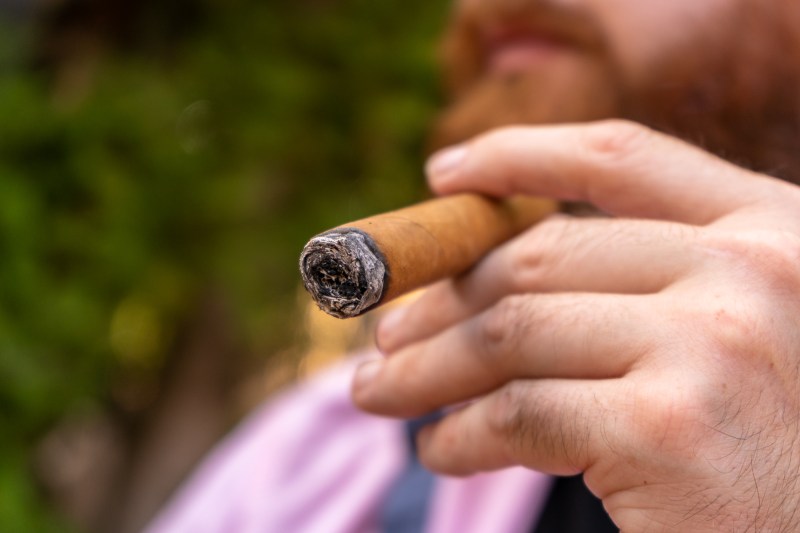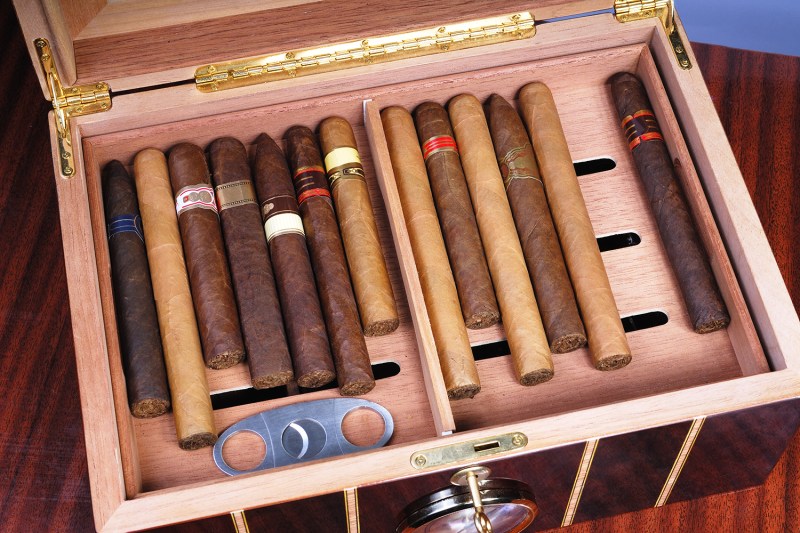Whether you just got a gift for having a baby or want to look cool while drinking your whiskey, there are plenty of occasions to realize you don't know the first thing about how to smoke a cigar. I know that I had a bunch of questions when I was an inexperienced cigar smoker. Things like, do you need to cut it? How much (if at all) should you inhale when you puff on your cigar? And how do you get the fat thing lit?
It's normal to be absolutely clueless when you begin smoking cigars, but there's something sexy about a person with a cigar in hand, especially if they know what they're doing. And that's what this guide to how to smoke a cigar is all about.
Of all the smokeable products out there, cigars — even cigars under $8 — are arguably the most luxurious. Over the years, the elegantly rolled stogie has been given the kind of status we generally reserve for fine wine, velvet house robes, and truffles. And for good reason, as the best of the bunch tend to have the same sort of nuanced and distinct origin that we expect from a fine vino.
But that's not to say it's the easiest hobby to stroll right into. In fact, cigars — like vintage Champagne, sailing, or cooking a lobster — can be a little intimidating. I'm here to quell that sensation and get you on the right track, cigar in hand. Here's the lowdown on how to smoke a cigar like a boss.

Pick your cigar
Before you start, we recommend checking out our guide to the cigar types you should know. It'll give you the lowdown on the types of cigars you're likely to encounter, as well as a better idea of those you're most likely to enjoy. On an even more basic level, the guide also offers more information about the difference between mild, medium, and bold cigars.
Essentially, you should look for a cigar the way you might look for that perfect piece of produce. In most cases, it ought to have integrity (meaning it's firm throughout) and no blemishes. The best place to start might be with the person working the counter at your local cigar shop. There, you'll not only be treated to a crash course should you ask for one, but you'll be able to take a few options out of the case and smell for yourself. This is the best way to see what your cigar palate is really after.

Cut the cigar
Unless you're camping or holed up somewhere far from civilization, there's no good reason to cut a cigar without a proper clipper. You'll end up with a poor snip that leaves you drawing from an uneven or frayed surface. Like pulling off a Band-aid, quick and direct is the way to go, and be sure to cut close to the end to maximize the length of your smoke. A fast cut generally produces a clean, even surface for maximum enjoyment.
Remember to keep your cutter clean. You can do so by simply dunking it in hot water for about an hour and giving it a bit of a scrub and towel dry. If you're in a bind with dulling blades, you can deburr the cutter as well. Roll up a small cylinder of aluminum foil, roughly the size of a cigar. Cut the foil with your cutter in half-inch increments, making multiple cuts. The foil will actually sharpen your cutter blades, allowing for a better chop of your next stogie.

Light the cigar
Many tools create fire, but the objective here is an even flame that won’t torch the cigar nor affect its inherent flavors. A torch lighter is the best kind of lighter for the task, and a vast improvement over a matchbook or conventional lighter.
Step 1: Position the cigar above the flame to "prime" the cigar.
Step 2: Spin it around slowly to burn the end evenly until you're treated to a nice, fairly uniform orange glow. That's when you know it's game time.
Step 3: At this point, the cigar is ready to smoke. Practice does make perfect here, so don't be upset if you char your first or create some unevenness. Like roasting a marshmallow, you'll get the hang of it, especially as you further familiarize yourself with the strength of your torch and how different types of cigars react to it.

Smoking the cigar
First things first: You do not inhale cigar smoke. Your lungs and body at large wouldn't like you much for that.
Step 1: The key here is a smooth, shallow puff, akin to pulling air through a straw without actually inhaling. Think of the smoke as something you mull over and even chew on more than ingest. Take in enough to fill your mouth and then blow it out.
Step 2: Repeat four or five times (maybe more) until your cigar starts producing thick white smoke.
Step 3: By now, the cigar should really be on autopilot. Slow your puffs and simply enjoy the fragrance and the feeling of having the thing in your hand. Keep the smoke in your mouth for 10-30 seconds to enjoy the aroma and taste.
Step 4: To keep it going, puff casually every minute or so. Rotate the cigar every few puffs to keep it dwindling evenly. Cigars can be pretty intense, so treat it like a marathon and not a sprint. Out-puffing your pal will only make you queasy.
Step 5: And remember: There's no rule that you have to smoke the whole thing in one sitting. Cigars can be paused and relit later on, no problem. It's suggested you do so within about two hours, however, as they are somewhat perishable.

Cigar storage and humidors
Unlike cigarettes, which can just hang out in their pack without much of a negative effect, cigars need to given the VIP treatment to maintain their freshness and flavor. If stored in the wrong conditions, cigars can dry out, and they will burn too quickly, ruining the flavor, or becoming too damp, which makes them difficult to smoke at best, and moldy at worst. To maintain that sweet spot of freshness, cigars need to be stored where there is about 70% humidity and at around 68 degrees Fahrenheit.
The best way to keep your cigars in the optimal condition is to store them in a humidor, which is a special box for cigar storage. Humidors are generally made of wood (though some can be made of metal) and may have an internal humidifier to maintain the right conditions in the humidor. Some humidors also have a hygrometer, so you can easily tell what the conditions are inside the humidor.

Things to avoid
While I covered the "dos" for introducing you to the world of cigar smoking, I must also cover some things to avoid to ensure you have the best cigar experience possible each and every time you light up.
According to GQ Tobaccos, a family, online tobacconist based in the U.K., these are some things to avoid when smoking a cigar.
- Don't wet the end of your cigar: According to GQ Tobaccos, you should never wet your cigar unless it isn't evenly burning. If that happens, just slightly moisten your fingertip and dab the area to slow the burn.
- Don't relight the cigar with it in your mouth: This comes down to manners, GQ Tobaccos says it's bad manners to relight a cigar in your mouth. Instead, hold it in your fingers and rotate it as you relight it.
- Don't clench the cigar in your teeth: Once again, this comes down to manners, clenching a cigar makes you look unsophisticated. Also, never speak with a cigar in your mouth, if you have something to say, take the cigar out of your mouth first and then speak.

Tips, tricks, and conventions of smoking cigars
Removing the cigar's label is a matter of personal preference. Some guys prefer to do it right away, and others like to leave it on for the duration of the smoke session. This is up to you, but if you want to remove it, we suggest leaving it on for a few minutes first. The heat of the cigar will loosen the adhesive, and you'll be less likely to damage the cigar's wrap when you take it off.
As you smoke, your cigar will begin to develop a head of ash on the tip. You do not need to tap this off like you would with a cigarette. Feel free to leave it there for a while. A big ash is a sign of a quality cigar — but don’t let it get super long either. Too much ash on the end can hinder airflow, which leads the tobacco to burn irregularly, and also affects the flavor. Try not to let it get longer than an inch or so, and when you ash it, don’t tap it off as you would with a cigarette — gently roll it on the ashtray until it breaks off.
Cigars pair well with whiskey
Sometimes, you may just want to smoke a cigar. Other times, though, you'll want to compliment your smoking with a stiff drink. If you do so, whiskey may be your natural first choice, and we have a full guide that will help you choose the ideal whiskey to pair with whatever cigar you happen to be smoking.
Of course, there's no requirement that you pair your cigar with whiskey. Your only objective should be finding combinations that work well for you. Find a cigar that works, and then pair that cigar with an alcoholic beverage that works. There is no "right" combination. Don't worry too much about whether your pairing preference makes sense to anyone else.
Cigars are a key part of poker night
If you've got the alcohol and a selection of the best cigars, the natural next step is to get your crew together for a poker night. If you choose to do that, be sure to choose a fairly expansive selection of alcohol and cigars, based on what those in your circle may like. Cigar tastes are like everything else — everybody's got their own opinion.
How old do you have to be to smoke a cigar?
The minimum age to smoke a cigar is 21 years old in the U.S. due to the federal Tobacco 21 law, passed in December 2019. The law prohibits the sale of tobacco products, including cigars, to anyone under the age of 21. This law applies to all retail establishments and persons, with no exceptions.
Some states have even stricter laws than the federal law. For example, in California, the minimum age to smoke a cigar is 21 years old, and it is also illegal to smoke a cigar in public places. It is important to note that even if you are over 21, smoking cigars can harm your health. Cigars contain nicotine, which is a highly addictive drug. Smoking cigars can also increase your risk of developing cancer, heart disease, and other health problems.




